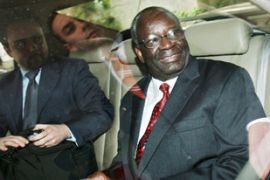Western governments, however, say the toll is probably much higher.
Ahead of Gambari’s visit, the military has all but shut down Yangon, leaving streets relatively quiet in contrast to the weeks of protests.
Lockdown
Small groups did defy the ban on gatherings of more than five people to taunt and curse troops and riot police manning barricades in the city centre, before scattering down alleys when security forces started to charge.
|
|
“I think all the people of Myanmar must act to get democracy for a better life”
aprat_1992, Denpasar, Indonesia
Send us your views
|
Myanmar’s government appears to have ignored calls for a peaceful end to what started as small-scale protests against rapid fuel price rises in August and which quickly grew into a mass uprising led by monks.
Selena Downes, Al Jazeera’s correspondent in Bangkok, said: “If you believe state-run media reports … peace and stability has been restored on the streets of Yangon.
“That is at odds with the pictures we’ve been seeing.”
Hundreds were arrested overnight, key religious sites sealed off and monasteries surrounded to prevent Buddhist monks from leading more demonstrations.
Few monks took part in the much smaller protests on Friday and Saturday around the barricades. Witnesses said many young monks were evading arrest by casting off their maroon robes and sheltering in houses disguised as laymen.
The scene was similar in the second city of Mandalay, home to many of Myanmar’s more than 400,000 monks, where troops surrounded major monasteries, a Chinese official said.
“Basically the situation is quiet. Armed police are stationed along major streets and at intersections,” he said.
In the northwestern coastal town of Sittwe, one resident said many younger monks had been forced to go back to their home towns. The only security officials on the streets were police, he said.
“Now in Sittwe very quiet. No more demonstrations, everything disperse,” he said. “No more fighting here.”
Japanese newspapers on Saturday said Tokyo will urge Myanmar to punish soldiers responsible for killing a Japanese journalist in the crackdown. Kenji Nagai, 50, a video-journalist for Tokyo-based APF News, was killed when the government sent troops into Yangon on Thursday.
About 80 demonstrators rallied outside Myanmar’s embassy in Tokyo, carrying pictures of Aung San Suu Kyi, the imprisoned pro-democracy leader, and what was believed to be Nagai’s body lying on the road against the backdrop of people rushing away from troops.
The deputy foreign minister of Japan, Mitoji Yabunaka, is scheduled to visit Myanmar on Sunday to deliver the demand to the government, the Yomiuri Shimbun newspaper said, quoting government sources.
Relations
Japan, one of the leading donors to Myanmar, will also consider a ban on Japanese investment in the country after receiving its reaction to the demand, the daily said.
Tokyo in 2003 suspended low-interest loans for major projects, such as infrastructure, to protest against the continued detention of Aung San Suu Kyi.
But Japan says aid continues for emergencies and humanitarian purposes.
|
|
Exports (2006)
Thailand: $2.1bn
India: $527m
China: $230m
Imports (2006)
China: $1.3bn
Thailand: $837m
Singapore: $620m
Official aid (2004): $121m
China, India and Japan are key contributors.
Black market: According to most estimates, the black economy matches its official counterpart.
(Sources: Asian Development Bank, 2007 Key Indicators, Reuters, UNDP, UNODC, Global Witness)
|
China, the military government’s main ally, publicly called for restraint for the first time on Thursday. But at the United Nations, China has ruled out supporting sanctions or a UN condemnation of the government’s use of force.
Beijing is estimated to have sold more than $2bn worth of weapons to the military government since 1989, including assault rifles, rocket launchers, and Chinese fighter jets.
India is thought to be the second biggest arms trade partner, with estimates suggesting weapons sales to the military government worth hundreds of millions.
Recent plans for New Delhi to sell its neighbour advanced light helicopters caused outrage when it was revealed that several parts of the Indian helicopter were made in the EU and US.
In exchange for its support, India gets cheap gas and timber from Myanmar. There are even plans for a new 2,400km-long pipeline to bring gas directly across Bangladesh straight to India.
And China’s strong support of the government has been rewarded with Myanmar supplying about $60bn worth of cut-price gas over 20 years.
Food aid
Street protesters were not the only ones suffering from the army crackdown.
The UN’s World Food programme on Saturday said Myanmar’s rulers have stopped or restricted the delivery of food relief to 500,000 people.
Paul Risley, WFP’s Asia spokesman, said: “The immediate concern is in Mandalay, which is our logistics hub for delivering food assistance to vulnerable people that we serve in Myanmar.”
All movements of food from the northern city of Mandalay, where monk-led protests began 11 days ago, have stopped, affecting WFP operations in Shan State and central areas.
The WFP says most of the country’s hungry are young children and people suffering from HIV/Aids and tuberculosis, with 60 to 70 per cent of children in some parts of Myanmar malnourished.
The WFP aims to raise $51m over three years, but said it so far has received just over $12m in donor funds since the campaign began earlier this year.

